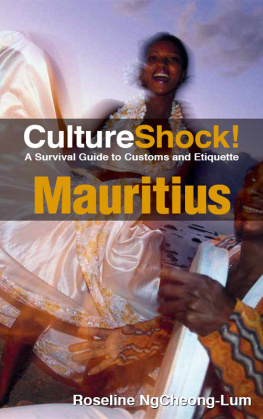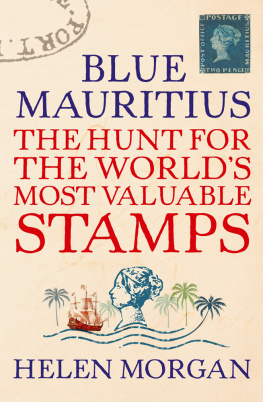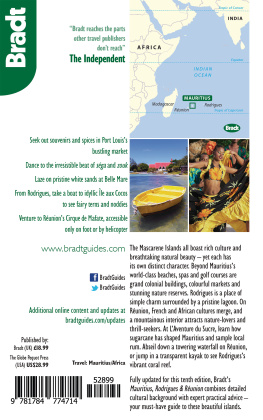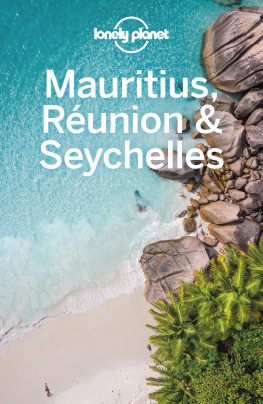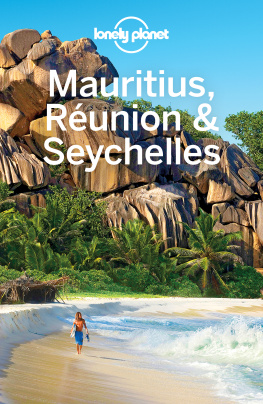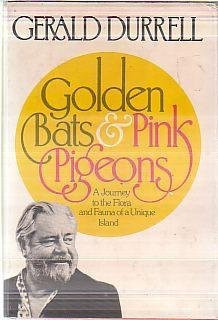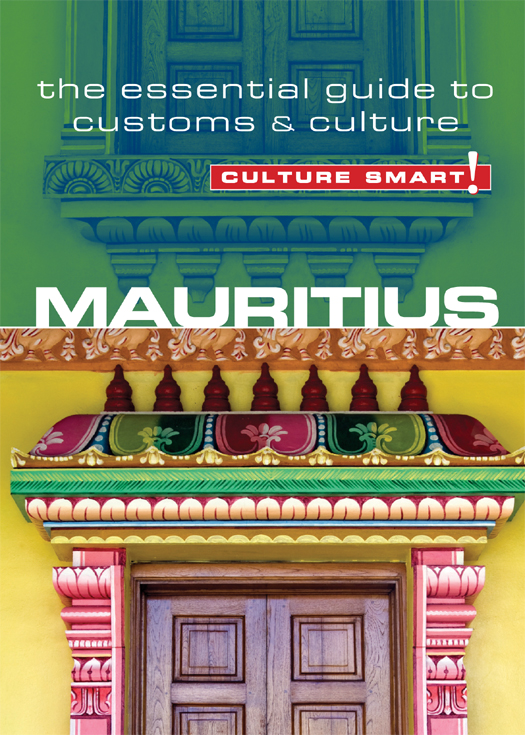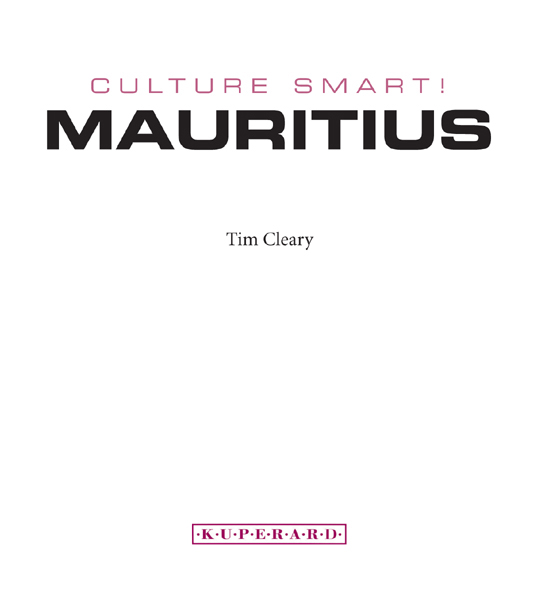eISBN: 978-1-85733-546-0
British Library Cataloguing in Publication Data
A CIP catalogue entry for this book is available from the British Library
Copyright 2011 Kuperard
All rights reserved. No part of this publication may be reprinted or reproduced, stored in a retrieval system, or transmitted in any form or by any means without prior permission in writing from the publishers.
Culture Smart! is a registered trademark of Bravo Ltd
First published in Great Britain 2011
by Kuperard, an imprint of Bravo Ltd
59 Hutton Grove, London N12 8DS
Tel: +44 (0) 20 8446 2440 Fax: +44 (0) 20 8446 2441
www.culturesmart.co.uk
Inquiries:
Series Editor Geoffrey Chesler
Cover image: Architectural detail of a Hindu temple, Mauritius iStockphoto.com
The photographs on are reproduced by permission of the author.
Images on the following pages reproduced under Creative Commons Attribution-Share Alike 3.0 Unported license: Thierry
Images on these pages reproduced under Creative Commons Attribution-Share Alike 2.0 Generic license: , Creative Commons Attribution-No Derivatives 2.0 Generic bengal*foam
On (below) Jean Andy
v3.1
About the Author
TIM CLEARY has a BA in French from the University of Leeds, where he specialized in Creole languages and the Francophone world, and an MA in Linguistics from the School of Oriental and African Studies, University of London. He has worked as a translator (French to English), has lived in Mauritius, and in 2010 married a Mauritian, with whom he is learning to speak Kreol. Tim currently lives in London and works at the famous Stanfords map and travel bookshop in Covent Garden, but he visits Mauritius regularly. He enjoys listening to Mauritian sega music and drinking the occasional can of Phoenix lager.
The Culture Smart! series is continuing to expand.
For further information and latest titles visit
www.culturesmart.co.uk
The publishers would like to thank CultureSmart!Consulting for its help in researching and developing the concept for this series.
CultureSmart!Consulting creates tailor-made seminars and consultancy programs to meet a wide range of corporate, public-sector, and individual needs. Whether delivering courses on multicultural team building in the USA, preparing Chinese engineers for a posting in Europe, training call-center staff in India, or raising the awareness of police forces to the needs of diverse ethnic communities, it provides essential, practical, and powerful skills worldwide to an increasingly international workforce.
For details, visit www.culturesmartconsulting.com
CultureSmart!Consulting and CultureSmart! guides have both contributed to and featured regularly in the weekly travel program Fast Track on BBC World TV.
contents
NOTE ON SPELLING
Throughout the text, you will find many Kreol words and others derived from Asian, African, and Malagasy languages. Many of these words are often only spoken, and others have variable spellings. In the case of Kreol words, we try to follow the spelling adopted in the Diksioner Morisien (the first monolingual Kreol dictionary) by Arnaud Carpooran.
When referring to the creole language spoken in Mauritius, we have used the spelling Kreol to distinguish it from Creole, a term used to refer to Mauritians of predominantly African and Malagasy ancestry.
Map of Mauritius
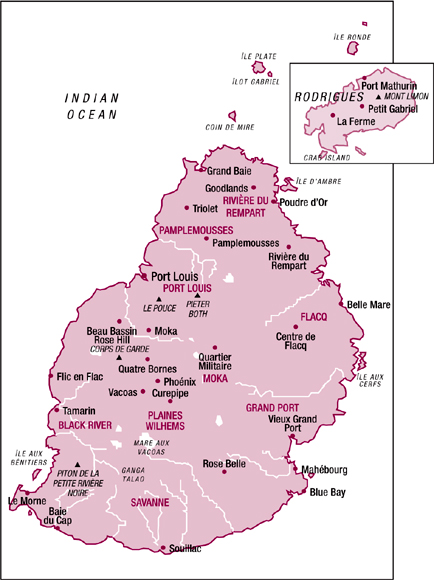
introduction
A small, exotic, multicultural island nation in the middle of the Indian Ocean, Mauritius gives the impression of a paradise on earth. Graceful palm trees, fine sandy beaches, blissful lagoons, and endless fields of lush, green sugarcane help to reinforce its romantic image.
This island nation is a very new society, forged over the past three centuries. Although similar in many ways to neighboring Runion and the Seychelles, and to Caribbean cultures such as Trinidad and Tobago where there is also a mixed population of African and Indian ancestry, Mauritius actually has a much greater South and East Asian influence than these islands. But that is not the whole story: a strong French cultural and linguistic heritage persists, even though the island was taken over and ruled by Britain for a hundred and fifty-eight years, and you only have to scratch the surface of many a Mauritian custom to find its African and Malagasy roots.
Although it would be difficult to claim a single overarching identity for the Mauritian people, certain traits recur in the accounts of foreign visitors: hospitality, warmth, and friendliness, albeit with an unexpected element of reserve. Above all, the most defining characteristic of the Mauritians is their multiculturalism. The islands rich cultural diversity reflects the origins of the people who settled there, and Mauritian language, food, and religion form an intoxicating medley. Other customs have been created locally and have become part of an authentic native culture that is shared by allsuch as sega, the distinctive, lively, and popular music of Mauritius.
Mauritius is not always, however, the haven of peace, love, and understanding that it may at first sight seem, and the reality is more complex and nuanced. Although today many Western and European-style customs are encroaching on both private and public life, Mauritians are ambivalent about this, and ancestral traditions are still firmly established in the daily lives of the population. On the downside, the Mauritians have a tendency to fight among themselves and to create communal stereotypes of their compatriotsCreoles are characterized as lazy and fun-loving, Indo- and Sino-Mauritians as clannish and nepotistic, and Franco-Mauritians as insular and racist, for example. However, the march of modernization and globalization means that many young, socially mobile Mauritians now share a common culture and outlook on life, where the sense of being Mauritian far outweighs ancestral ties and divisive communalism.
This book aims to make sense of the modern and the traditional, of the complex legacy of shared and ancestral cultures. It will help you to navigate your way through the contradictions of Mauritian society and to enrich your experience of this fascinating and beautiful island.
Key Facts
| Official Name | Rpublique de Maurice (Republic of Mauritius) |
| Capital City | Port Louis (pop. 150,000) |
| Main Towns | Beau Bassin, Rose Hill, Quatre Bornes, Vacoas, Phonix, Curepipe, Mahbourg, Port Mathurin (Rodrigues) |
| Area | 788 sq. miles (2,040 sq. km), incl. dependencies of Rodrigues, Saint Brandon, and Agalega |
| Climate | Tropical maritime, with southeast trade winds. Hot, wet, humid summer, NovemberApril; dry, cooler winter, MayOctober | Risk of heavy rain and cyclones during summer |
| Population | 1.3 million (2010 estimate) |
|


